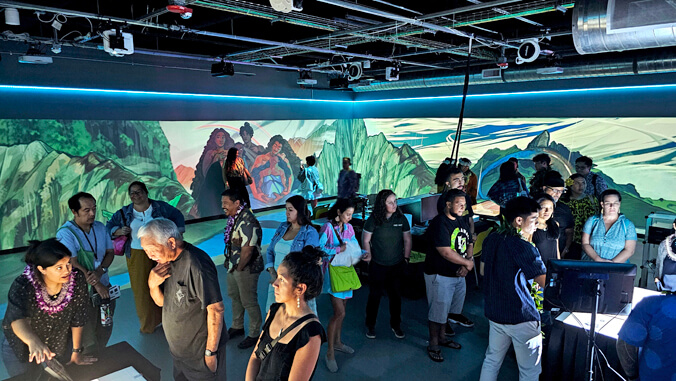
Student-developed Indigenous data visualization projects took center stage at the University of Hawaiʻi–West Oʻahu on September 27. The Indigenous Data Hub Fellows Hōʻike, hosted by the UH Office of Indigenous Knowledge and Innovation (OIKI), showcased innovative works blending ancestral knowledge with modern data visualization.
Five students from Leeward Community College and UH Mānoa participated in the inaugural “Indigenous Data Hub Fellows” program, where they learned an equitable community-centered co-design practice, collaborated on place-based data visualization projects relevant to the Hawaiian community, and took advantage of the high-tech resources in the Create(x) lab housed in the Academy for Creative Media Building. The lab features immersive visualization environments such as a projection system that projects onto three walls and the floor for various augmented virtual environments.

“As a Native Hawaiian studying computer science in the data science track at UH Mānoa, this experience has allowed me to integrate the practices of my culture as kānaka ʻōiwi with the knowledge and skill set of a computer scientist, nurturing two critical parts of my identity,” said undergraduate student Shaelyn Loo. “It has been a transformative journey that has shaped my personal and professional growth in ways I never expected.”
OIKI Director Kamuela Enos said the Indigenous data hub’s goal is to provide contemporary data visualization technology to community practitioners to allow them to show the impact of their work, while training youth that live in their community the fundamentals of both ancestral and contemporary sciences.
“Our intention with this project is to equitably engage with both regional community organizations and students in pairing the ancestral sciences and technologies that have allowed our ancestors to be self-sufficient for millennia with contemporary technologies,” Enos said. “The Indigenous data hub model focuses on four key components: a named geography, the ancestral practices that still exist within that geography, the community organizations that are still holding on to these practices in that geography, and the next generation learners that live within that geography.”
Mapping, sailing, restoring

The students worked on three projects:
- Moʻolelo Mapper—An immersive visualization project intended to augment a classroom with illustrations to weave together place, story and ways to investigate lessons passed on from ancestors. This is in collaboration with Kumu Uʻi Keliʻikuli from Leeward CC.
- Hoʻokele Table—An augmented visualization table intended to supplement the curriculum around designing sail plans for non-instrumental navigation. The simulation allows for students to become familiar with the natural phenomena that need to be taken into account while navigation on the open ocean. This is in collaboration with Kumu Kekai Lee from Leeward CC.
- Kipuka o Kahinahina—An augmented visualization table intended to share the story of the restoration of kālua mahi (sinkholes) in Kalaeloa. These kālua mahi were originally used for agriculture, and archaeologist and kumu hula Ulukoa Duhaylonsod along with other community volunteers are restoring this practice to propagate and preserve endangered endemic species of plants such as ʻEwa Hinahina. The table visualizes observation data from the site over time.
“Working with these talented students has been incredibly rewarding,” said Create(x) Director Kari Noe. “Learning how to equitably co-design data science tools, visualization software, and any technology with community partners and faculty is a critical skill and practice, but it is challenging. These students have a passion to learn these skills to be able to create projects that will bring a positive impact to their communities. I’m happy we are able to give them the space to.”
Students also learned skills from mentors such as Kūhaʻo Zane, Solomon Enos and Mikiʻala Lidstone who advised the fellows and taught them about Indigenous design, creative practice and community-centered design, respectively.
Along with Loo, other students who participated include Austin Cataluna (Leeward CC, engineering), Halaʻi Napulehua (Leeward CC, computer sciences), Leilehua Kila (Leeward CC, Hawaiian studies) and Kieren McKee (UH Mānoa, digital media).
The intention of the Indigenous Data Hub project is to expand its network to other locations around the state to provide access to this kind of programming to local students, starting with Leeward CC. The Indigenous Data Hub project was funded in part by the National Science Foundation EPSCoR award 2149133, the Academy for Creative Media System and Abundant Intelligences.

